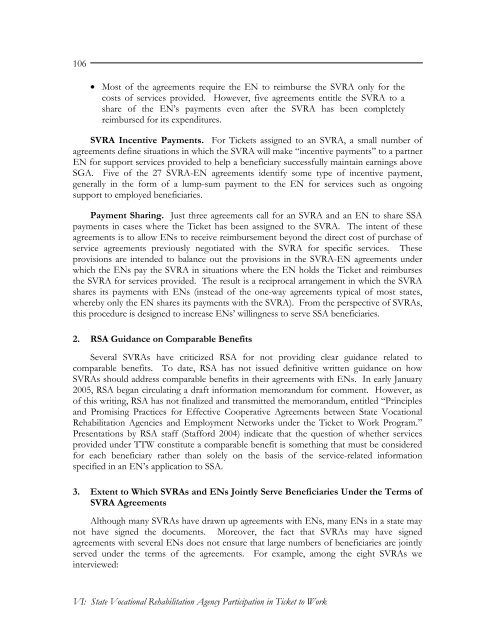Evaluation of the Ticket to Work Program, Implementation ...
Evaluation of the Ticket to Work Program, Implementation ...
Evaluation of the Ticket to Work Program, Implementation ...
You also want an ePaper? Increase the reach of your titles
YUMPU automatically turns print PDFs into web optimized ePapers that Google loves.
106• Most <strong>of</strong> <strong>the</strong> agreements require <strong>the</strong> EN <strong>to</strong> reimburse <strong>the</strong> SVRA only for <strong>the</strong>costs <strong>of</strong> services provided. However, five agreements entitle <strong>the</strong> SVRA <strong>to</strong> ashare <strong>of</strong> <strong>the</strong> EN’s payments even after <strong>the</strong> SVRA has been completelyreimbursed for its expenditures.SVRA Incentive Payments. For <strong>Ticket</strong>s assigned <strong>to</strong> an SVRA, a small number <strong>of</strong>agreements define situations in which <strong>the</strong> SVRA will make “incentive payments” <strong>to</strong> a partnerEN for support services provided <strong>to</strong> help a beneficiary successfully maintain earnings aboveSGA. Five <strong>of</strong> <strong>the</strong> 27 SVRA-EN agreements identify some type <strong>of</strong> incentive payment,generally in <strong>the</strong> form <strong>of</strong> a lump-sum payment <strong>to</strong> <strong>the</strong> EN for services such as ongoingsupport <strong>to</strong> employed beneficiaries.Payment Sharing. Just three agreements call for an SVRA and an EN <strong>to</strong> share SSApayments in cases where <strong>the</strong> <strong>Ticket</strong> has been assigned <strong>to</strong> <strong>the</strong> SVRA. The intent <strong>of</strong> <strong>the</strong>seagreements is <strong>to</strong> allow ENs <strong>to</strong> receive reimbursement beyond <strong>the</strong> direct cost <strong>of</strong> purchase <strong>of</strong>service agreements previously negotiated with <strong>the</strong> SVRA for specific services. Theseprovisions are intended <strong>to</strong> balance out <strong>the</strong> provisions in <strong>the</strong> SVRA-EN agreements underwhich <strong>the</strong> ENs pay <strong>the</strong> SVRA in situations where <strong>the</strong> EN holds <strong>the</strong> <strong>Ticket</strong> and reimburses<strong>the</strong> SVRA for services provided. The result is a reciprocal arrangement in which <strong>the</strong> SVRAshares its payments with ENs (instead <strong>of</strong> <strong>the</strong> one-way agreements typical <strong>of</strong> most states,whereby only <strong>the</strong> EN shares its payments with <strong>the</strong> SVRA). From <strong>the</strong> perspective <strong>of</strong> SVRAs,this procedure is designed <strong>to</strong> increase ENs’ willingness <strong>to</strong> serve SSA beneficiaries.2. RSA Guidance on Comparable BenefitsSeveral SVRAs have criticized RSA for not providing clear guidance related <strong>to</strong>comparable benefits. To date, RSA has not issued definitive written guidance on howSVRAs should address comparable benefits in <strong>the</strong>ir agreements with ENs. In early January2005, RSA began circulating a draft information memorandum for comment. However, as<strong>of</strong> this writing, RSA has not finalized and transmitted <strong>the</strong> memorandum, entitled “Principlesand Promising Practices for Effective Cooperative Agreements between State VocationalRehabilitation Agencies and Employment Networks under <strong>the</strong> <strong>Ticket</strong> <strong>to</strong> <strong>Work</strong> <strong>Program</strong>.”Presentations by RSA staff (Stafford 2004) indicate that <strong>the</strong> question <strong>of</strong> whe<strong>the</strong>r servicesprovided under TTW constitute a comparable benefit is something that must be consideredfor each beneficiary ra<strong>the</strong>r than solely on <strong>the</strong> basis <strong>of</strong> <strong>the</strong> service-related informationspecified in an EN’s application <strong>to</strong> SSA.3. Extent <strong>to</strong> Which SVRAs and ENs Jointly Serve Beneficiaries Under <strong>the</strong> Terms <strong>of</strong>SVRA AgreementsAlthough many SVRAs have drawn up agreements with ENs, many ENs in a state maynot have signed <strong>the</strong> documents. Moreover, <strong>the</strong> fact that SVRAs may have signedagreements with several ENs does not ensure that large numbers <strong>of</strong> beneficiaries are jointlyserved under <strong>the</strong> terms <strong>of</strong> <strong>the</strong> agreements. For example, among <strong>the</strong> eight SVRAs weinterviewed:VI: State Vocational Rehabilitation Agency Participation in <strong>Ticket</strong> <strong>to</strong> <strong>Work</strong>
















